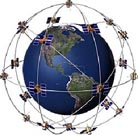Next cool trend: GPS tags from new phones and data loggers
 Berlin - Watch out for geo-tagging. A previously nerdy hobby that aims to map and describe every spot on the Planet Earth may be about to go mainstream, thanks to a rash of new, easy-to-use gadgets.
Berlin - Watch out for geo-tagging. A previously nerdy hobby that aims to map and describe every spot on the Planet Earth may be about to go mainstream, thanks to a rash of new, easy-to-use gadgets.
All the devices use the Global Positioning System (GPS), the network of orbiting satellites which issue signals that are currently best known for guiding satellite navigation (sat-nav) devices in cars.
GPS can also be used to calculate the exact latitude and longitude of a place - a "point of interest" in geo-tagging jargon - or of a route, which simply consists of a series of fixes known as "waypoints."
The latest products allow people to quickly report errors in published maps or easily record interesting routes which they have travelled and see those routes published seconds later on a website.
The urge that seems to be driving the geo-tagging craze is the desire to discover routes and claim that you described them first.
Christopher Columbus and James Cook would be amazed at how easy it is for untrained people to help chart the globe in the 21st century.
Users of OpenStreetMap have been using that open-source mapping website to publish little-known short-cuts for pedestrians and cyclists through cities that do not appear on maps for motorists.
At the IFA consumer-electronics trade show running till Wednesday, Corinne Vigreux, managing director of Dutch sat-nav maker TomTom, said her company's maps needed 4 million corrections last year as transport authorities altered road networks.
"The best way to keep up to date is feedback from our community of users," she said. Under TomTom's Map Share scheme launched last year, users can report when one-way streets change direction, or edit street names that no longer match those on actual road signs.
Many people do just that, insisting that the facts be straightened out, even though there is no economic incentive in it for them.
At IFA, TomTom launched its new Go 940 Live sat-nav. It has simple touch-screen icons to report changes, which are then transmitted to all the other Go 940 receivers in cars after TomTom has checked them.
Companies now appear to be looking at popularizing geo-tagging, which means going beyond the altruism of the few and appealing to the baser urges of millions whose main "point of interest" is themselves.
Finnish handset manufacturer Nokia is this week running a marketing campaign in Berlin and main German cities, encouraging young urbanites to use its Navigator phones, which can transmit the user's exact geographic position as a sort of come-hither message.
Using GPS, another Navigator phone can then give street directions to the spot where Person One is expectantly waiting for Person Two.
Satellite-navigation makers such as Garmin invite users to upload their own routes for other users to use, or to download routes created by other users. Garmin calls that feature Zumo Connect.
Independent companies have been exploring the same business. A German company, Trackspace, is trying to encourage people to post the routes of their favourite mountain hikes or leisure bike rides in the Alps and around Munich on its website.
Trackspace users do not need to own a GPS phone or a sat-nav guidance system. Instead they use a GPS data logger, a pocket device costing about 60 euros (90 dollars) that gets its fixes from satellites and stores the waypoints as the user walks or cycles.
The route, including altitudes and time taken, can be transmitted wirelessly to a mobile phone in another pocket using Bluetooth signals and uploaded using free phone software to the Trackspace website.
The company says the website can even be used to watch somebody's position live via the internet if the hiker wishes.
The hobby is now being helped along by wide availability of data loggers from several manufacturers, many costing less than 100 dollars. A German company, Hama, announced a new model at IFA.
Unlike in-car navigation devices, the data loggers usually have no power-hungry display or other extras, because they must be able to operate on tiny batteries for 12 to 15 hours at a stretch.
Garmin's battery-powered eTrex guidance devices for walkers and cyclists do the job too, but are more expensive.
A data logger by itself is the only device needed if a user does not want to be guided or to stay permanently connected and prefers to wait until returning home to upload the routes to a website using a personal computer.
A US-based website for hiking enthusiasts, TripTracker. net, offers dozens of tourist routes through remote parts of Asia which have been recorded by hikers actually walking, running or biking along the trails.
Non-commercial OpenStreetMap is perhaps the most ambitious geo-tagging scheme of all: it aims to map highways, streets and footpaths over the whole globe and to give away the maps on the internet to anyone who wants them.
It is closely related to Wikipedia, the online encyclopedia which survives on a little money and a lot of community spirit, but instead of trying to record all human knowledge, OpenStreetMap is dedicated to recording and describing the world's land surface.
Contributors to OpenStreetMap take handheld GPS devices with them on journeys, or go out specially to record GPS tracks. They record street names, and other landmarks using notebooks, digital cameras and voice-recorders and enter these on the website by hand. (dpa)